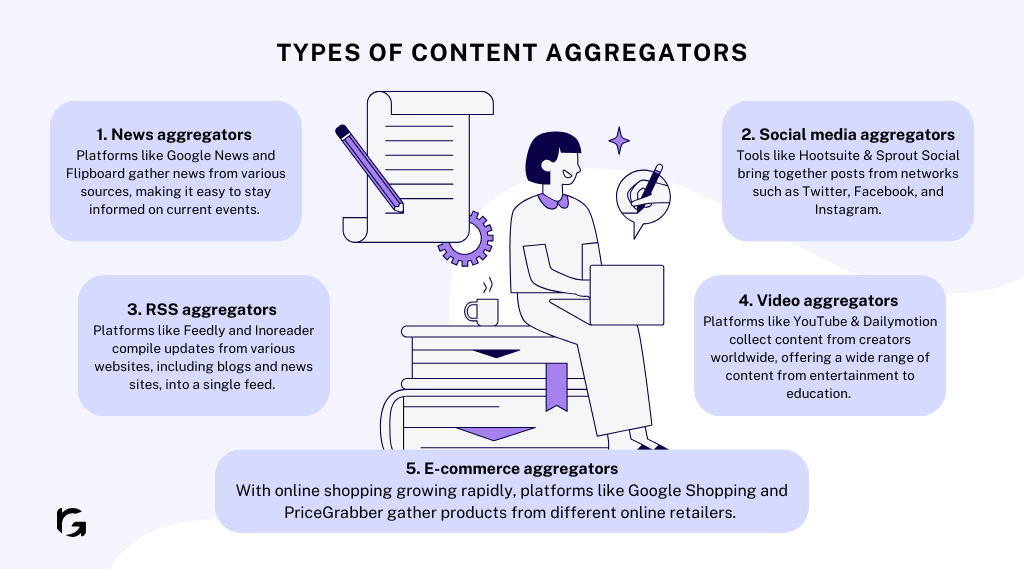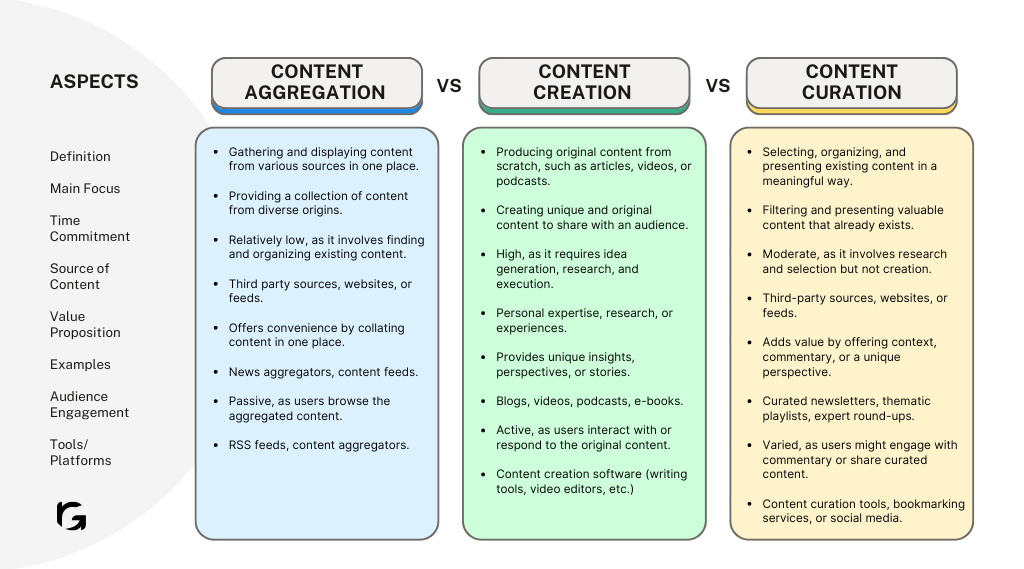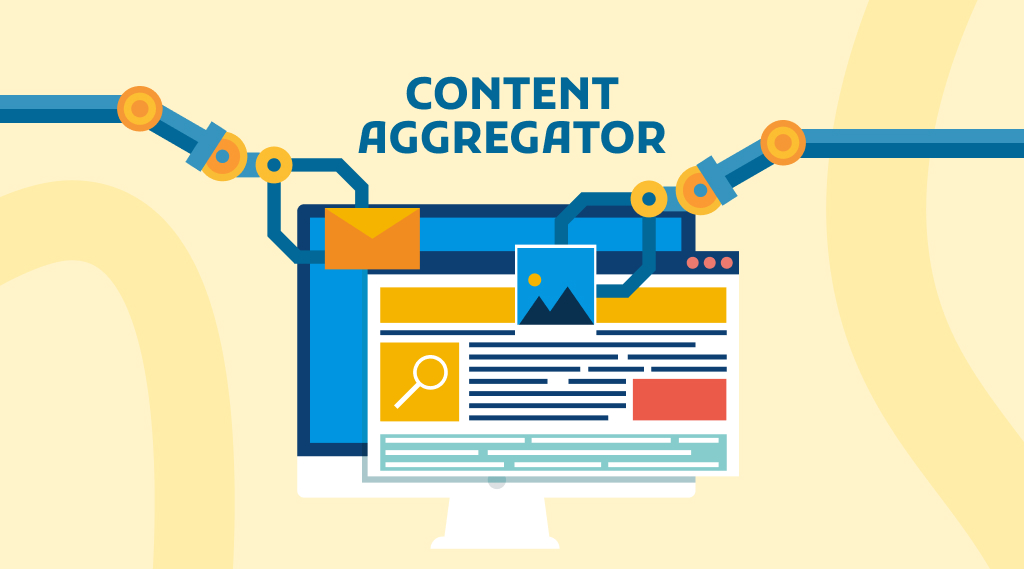Introduction
Finding useful information on the internet can be time-consuming, as it’s scattered across many websites. Wouldn’t it be convenient if all this information was in one place? That’s the role of content aggregator sites.
A study from last year shows these sites have experienced a surge in user engagement, especially through personalized feeds and recommendations. Some, using machine learning and AI algorithms, have reported up to a 30% increase in user retention.
Content aggregators gather information from across the web in one spot, making them valuable for content marketing strategies.
In this article we will gain knowledge on these content aggregators, its working, types, and the platforms to explore.
What is a content aggregator?
A content aggregator is a person, company, or software tool that gathers content from different online sources for reuse. This content can include blogs, social media posts, videos, and news articles covering various topics such as digital marketing, sports, and technology.
A content aggregator doesn’t create its own unique content. Instead, it combines content from various sources into one place, making it easier to find and access information on a specific topic.
You can use content aggregators to distribute content and get more views on your blogs and articles, helping potential customers find you online. You can also use them as a source of information to create engaging content for your business.
Now that we know the basics let us shift our focus on the working of content aggregators, let’s get started!!
How do content aggregators work?
Content aggregators are platforms or services that collect information, news, and content from various sources across the Internet, curate it, and then present it in a consolidated and organized manner to users.
They work by automating the process of gathering and displaying content based on certain criteria, such as topic, popularity, or relevance. Here’s a detailed breakdown of how content aggregators work:
- Source identification
- Data collection
- Content curation
- Presentation
- User interaction
- Monetization
1. Source identification
- Automatic discovery: Many aggregators use web crawlers or RSS feeds to automatically discover content from a variety of sources, such as blogs, news websites, and social media platforms.
- User submissions: Some platforms allow users to submit content directly, which can then be included in the aggregation feed.
- Partnerships: Aggregators may also form partnerships with content creators and publishers to directly receive content or get better access to it.
2. Data collection
- Scraping: This involves extracting content from web pages. Content aggregators often scrape headlines, summaries, and sometimes full articles, along with associated media like images or videos.
- APIs: Many websites offer APIs (Application Programming Interfaces) that allow aggregators to fetch content in a structured format, making it easier to integrate and manage.
3. Content curation
- Filtering: Content is filtered based on predefined criteria to ensure relevance to the aggregator’s audience. This might include filtering by keywords, content type, publication date, or popularity.
- Categorization: Aggregated content is categorized into topics or themes to facilitate easier navigation and consumption. This can be done manually or using machine learning algorithms.
- Ranking: Algorithms rank the content based on factors like freshness, user engagement, and credibility to prioritize what appears first or most prominently.
4. Presentation
- User interface: Aggregators design their platforms to display content in an easily digestible format, often with options to view more details or read the original source.
- Personalization: Many aggregators offer personalized feeds based on user preferences, previous interactions, or demographic information.
5. User interaction
- Engagement features: Features like search, filters, comments, and sharing options enhance user interaction and engagement with the content.
- Feedback loops: User behavior (what they click on, how long they read, what they ignore) can inform the algorithm to improve content curation and presentation.
6. Monetization
- Advertisements: Many aggregators include advertisements as a primary revenue source. These can be targeted based on the content or user demographics.
- Subscription models: Some offer premium services with additional features, such as ad-free browsing or access to exclusive content.
- Affiliate links: Including affiliate marketing links within the content, where the aggregator earns a commission for referrals or sales.
Content aggregators play a significant role in how information is consumed online, helping users discover, filter, and access diverse sources of content efficiently.
7 Content aggregator tools or examples for you to explore in 2024
This year, many new and improved content aggregation platforms for gathering and sharing content are changing how we find and enjoy information online.
These tools are made to suit different people’s interests and make it easier to read and watch what we like:
- Feedly
- Buzzsumo
- ContentStudio
- Curata
- Mix (formerly StumbleUpon)
1. Feedly
Feedly remains a powerhouse for RSS feed aggregation, enabling users to subscribe to their favorite websites, blogs, or publications. It organizes subscribed content into customizable feeds, allowing users to gather, categorize, and access updates from various sources in one unified interface.
2. Flipboard
Renowned for its visually engaging magazine-style layout, Flipboard aggregates content based on user-selected topics, presenting it in a visually appealing format akin to a personalized magazine. It operates by curating articles, images, and videos from multiple sources, presenting them in an interactive, customizable layout.
3. Pocket
Pocket is a content aggregator focused on bookmarking and saving articles, videos, or web pages for later consumption. It allows users to save content from various sources, organizing it into a centralized library accessible across devices, even offline.
4. BuzzSumo
BuzzSumo aggregates trending or popular content across social media platforms. It primarily caters to content discovery and analysis, highlighting influential content and key performance metrics. It analyzes shares and engagements, providing insights into content performance and trends within specific niches.
5. ContentStudio
ContentStudio is a comprehensive content aggregator that combines content discovery, curation, scheduling, and publishing functionalities. It aggregates content from diverse sources, facilitating collaboration and distribution across various platforms.
6. Curata
Aimed at content marketing and curation, Curata uses AI-powered algorithms to curate, categorize, and recommend content relevant to specific industries or topics. It automates content aggregation, filters out irrelevant content, and suggests curated pieces for marketing strategies.
7. Mix (formerly StumbleUpon)
Mix focuses on personalized content discovery, offering users a tailored selection of articles, videos, or web content based on their interests. It aggregates content based on user preferences, providing a continuously updated feed of recommended content.
These were the tools which actually help in content aggregation now Lets us now see how does it benefit marketers un real world.
How can content aggregators help marketers?
Using content aggregators can greatly benefit marketers and brands. Here are a few key points:
- Reach a larger audience
- Increase audience engagement
- Boost revenue
Reach a larger audience
Content aggregators give marketers and brands access to a broader audience. This is because people like to visit one place to find everything they need.
Delivering valuable and relevant content in one place makes users happy. It helps attract more visitors, boosting brand awareness and new opportunities.
Increase audience engagement
Engagement is crucial to retain and grow your audience. Interesting, unique content helps engage your audience, encouraging comments or sharing on social media.
Content aggregation enables marketers to feature hot topics, stimulating audience interaction and strengthening marketing campaigns.
Boost revenue
The benefits of reaching and engaging a broader audience can convert visitors into customers.
This leads to more sales, conversions, and customer acquisitions, ultimately growing the brand.
What are the types of content aggregators?
Content aggregators come in various forms to cater to different content consumption needs and preferences:

- News aggregators
- Social media aggregators
- RSS aggregators
- Video aggregators
- E-commerce aggregators
1. News aggregators
Platforms like Google News and Flipboard gather news from various sources, making it easy to stay informed on current events. Users can customize their feed based on topics they are interested in, offering a quick way to catch up on local and global news.
2. Social media aggregators
Tools like Hootsuite and Sprout Social bring together posts from networks such as Twitter, Facebook, and Instagram. This helps individuals and businesses manage their social media presence, monitor trends, and interact with their audience.
3. RSS aggregators
Platforms like Feedly and Inoreader compile updates from various websites, including blogs and news sites, into a single feed. This makes it easier to follow developments on specific topics or areas of interest, saving time and effort.
4. Video aggregators
Platforms like YouTube and Dailymotion collect content from creators worldwide, offering a wide range of content from entertainment to education. Users can explore new videos recommended by the platform’s algorithms, finding content that matches their interests.
5. E-commerce aggregators
With online shopping growing rapidly, platforms like Google Shopping and PriceGrabber gather products from different online retailers. This helps consumers compare prices, read reviews, and make informed purchasing decisions, making online shopping more accessible and convenient.
Difference between content aggregation, content creation, and content curation

Wrap up
Content aggregators can be a useful part of your marketing strategy, helping you reach more people and grow your brand. When sourcing content from other places, remember search engine optimization (SEO) to rank higher in search engine results.
With this in mind, choose an aggregator that suits your brand. Remember to respect copyright and fair use laws.
Connect with us for comprehensive marketing support and let’s take your brand to new heights together.


